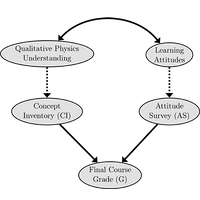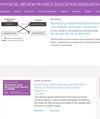观察性物理教育研究中统计因果推理的关键问题
IF 2.6
2区 教育学
Q1 EDUCATION & EDUCATIONAL RESEARCH
Physical Review Physics Education Research
Pub Date : 2023-11-20
DOI:10.1103/physrevphyseducres.19.020160
引用次数: 1
摘要
最近对物理教育研究(PER)研究的批评,在没有干预的情况下,从观察数据中得出因果推论时,提出了关键问题。为了响应对PER中“因果推理入门”的呼吁,本文讨论了统计因果推理中的一些基本问题。在回顾这些问题时,我们讨论了在其他领域普遍应用的成熟的因果推理方法,并讨论了它们在PER中的应用。使用模拟数据集,我们说明(i)为什么因果推理分析应该控制混杂因素,而不是控制中介和碰撞因素;(ii)多个提出的因果模型可以拟合高度相关的数据集。最后,我们讨论了如何使用这些因果推理方法来表示和解释定量PER中存在的问题。在整个过程中,我们讨论了观察性研究中的一个核心问题:一个适合所提出的因果模型的良好定量模型并不足以支持所提出的模型胜过其他模型。为了解决这个问题,我们建议在PER中进行观察性研究,得出统计因果推论:提出未来的干预研究并预测其结果。与理论可以激发物理学实验的方式一样,PER的观察性研究可以预测干预的因果效应,而未来的干预研究可以直接测试这些预测。本文章由计算机程序翻译,如有差异,请以英文原文为准。

Critical issues in statistical causal inference for observational physics education research
Recent critiques of physics education research (PER) studies have revoiced the critical issues when drawing causal inferences from observational data where no intervention is present. In response to a call for a “causal reasoning primer” in PER, this paper discusses some of the fundamental issues in statistical causal inference. In reviewing these issues, we discuss well-established causal inference methods commonly applied in other fields and discuss their application to PER. Using simulated data sets, we illustrate (i) why analysis for causal inference should control for confounders but not control for mediators and colliders and (ii) that multiple proposed causal models can fit a highly correlated dataset. Finally, we discuss how these causal inference methods can be used to represent and explain existing issues in quantitative PER. Throughout, we discuss a central issue in observational studies: A good quantitative model fit for a proposed causal model is not sufficient to support that proposed model over alternative models. To address this issue, we propose an explicit role for observational studies in PER that draw statistical causal inferences: Proposing future intervention studies and predicting their outcomes. Mirroring the way that theory can motivate experiments in physics, observational studies in PER can predict the causal effects of interventions, and future intervention studies can test those predictions directly.
求助全文
通过发布文献求助,成功后即可免费获取论文全文。
去求助
来源期刊

Physical Review Physics Education Research
Social Sciences-Education
CiteScore
5.70
自引率
41.90%
发文量
84
审稿时长
32 weeks
期刊介绍:
PRPER covers all educational levels, from elementary through graduate education. All topics in experimental and theoretical physics education research are accepted, including, but not limited to:
Educational policy
Instructional strategies, and materials development
Research methodology
Epistemology, attitudes, and beliefs
Learning environment
Scientific reasoning and problem solving
Diversity and inclusion
Learning theory
Student participation
Faculty and teacher professional development
 求助内容:
求助内容: 应助结果提醒方式:
应助结果提醒方式:


